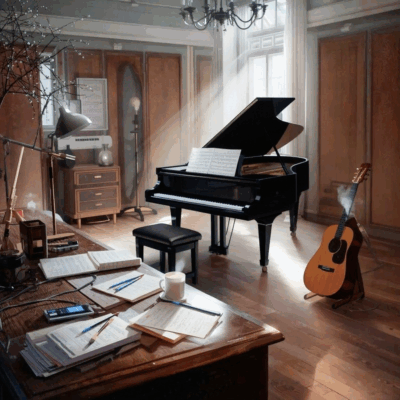How a song is born: exploring the many paths of music composition
 Temps de lecture/Reading time : 2 minutes
Temps de lecture/Reading time : 2 minutes
Musical composition is a true journey. Every piece is born from an idea, a gesture, or an emotion, and the place it takes us is often unpredictable. That’s what makes creation so fascinating: you start from a single point, and end up exploring sonic territories you never could have imagined.
There are countless ways to approach composition. Some musicians begin with lyrics, a story, or an emotion they want to express through music. Others start with a melody, a vocal or instrumental motif that becomes the backbone of the piece. Some build their world around rhythm, a groove, or even a single sound.
Starting from an instrumental base
Personally, I often compose starting from a guitar riff or a harmonic progression on the keyboard. I like to lay those foundations first, then build around them—finding the right tension, color, and emotion. Sometimes I begin with a drum pattern, because rhythm alone can inspire an entire musical structure. A simple loop can open unexpected doors.
Starting from lyrics or storytelling
Other creators—especially in lyric-driven music—start with words. They write a story, a poem, or a strong idea, then look for the music that will bring it to life. In this case, the structure of the song often grows from the rhythm of the phrases, the breathing of the text, or a key word that turns into melody. It’s a narrative approach, where music becomes the natural extension of meaning.
Starting from melody
Many composers—especially in pop music or film scoring—begin with a melody. A sung line, a whistle, a quick recording on a phone… it’s often in these raw moments of inspiration that the most memorable themes are born. Harmony then gives that melodic idea depth, contrast, and emotional weight.
Starting from sound or atmosphere
In the digital age, some musicians begin with a single sound: a transformed noise, a synthetic texture, an ambient layer. Electronic artists and film composers particularly love this sensory approach. The sound itself becomes the starting point—the engine of imagination. A reverb, a filter, or a well-placed distortion can suggest an entire world.
The creative process: from seed to forest
Whatever the starting point, the process of composition usually follows a similar path: you begin with a seed—an idea fragment—and nurture it. At first, everything is fragile. You search, you circle, you doubt. Then suddenly, something resonates, coherence appears, and the music seems to find its own direction.
Composition then becomes a dialogue between intuition and construction. You have to listen to what the music “wants,” while still guiding it. This constant back-and-forth between spontaneity and reflection is the heart of the creative process.
There are also the “happy accidents”—those moments when a wrong note, an unexpected chord change, or a technical mistake leads to a new idea. Creativity thrives on detours and surprises. Often, the final result has little to do with the initial intention, and that’s what makes the journey so exciting.
An endless journey
Composing is like exploring a new world with every piece. You start with a spark, and through layers, trials, and discoveries, the music takes on a life of its own. Sometimes it feels as though it’s guiding you. The final result is often far from what you first imagined—and it’s precisely that mystery, that transformation, that makes you want to start again and again.
Composition is not just a technical act; it’s a mirror of who we are at a given moment. Each piece, in its own way, tells the story of our inner journey.